Valentin Liévin
Advancing Conversational Diagnostic AI with Multimodal Reasoning
May 06, 2025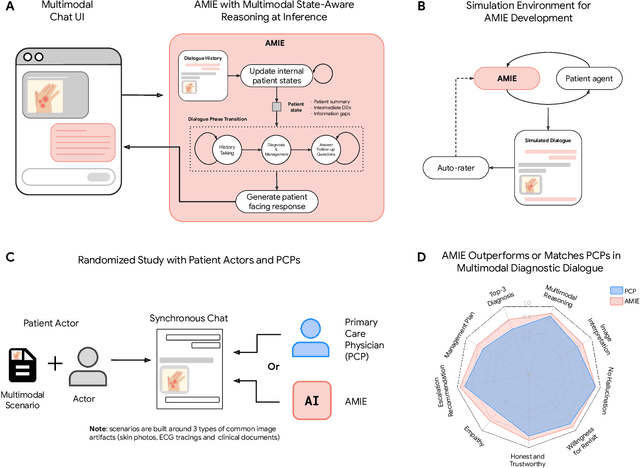
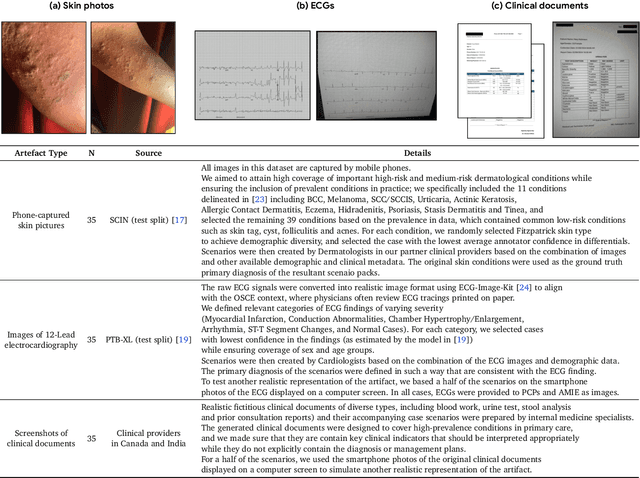
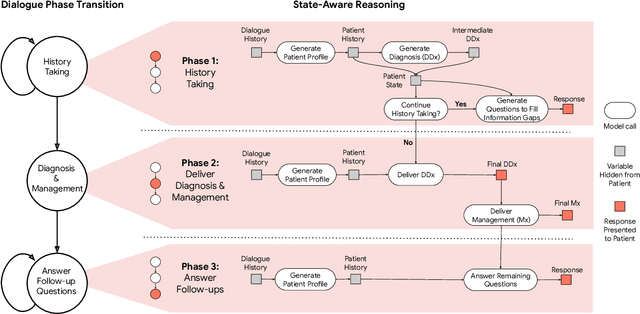
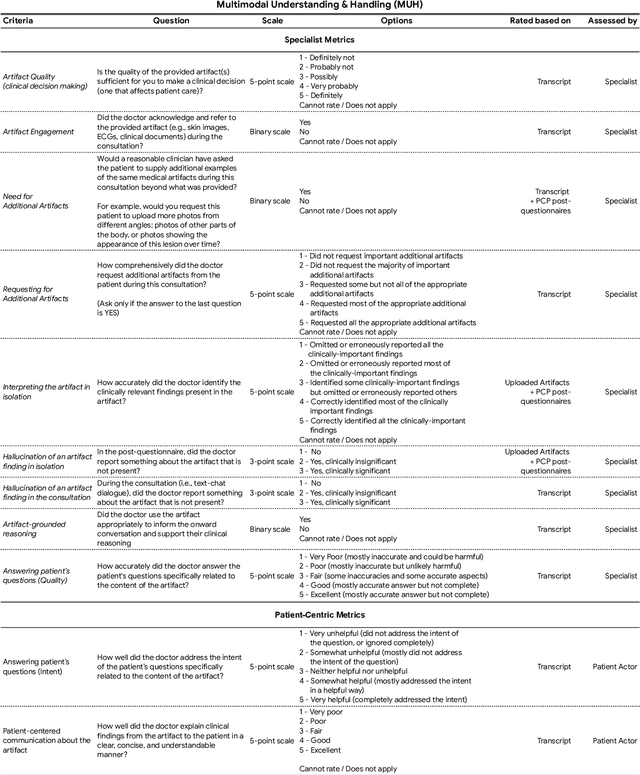
Abstract:Large Language Models (LLMs) have demonstrated great potential for conducting diagnostic conversations but evaluation has been largely limited to language-only interactions, deviating from the real-world requirements of remote care delivery. Instant messaging platforms permit clinicians and patients to upload and discuss multimodal medical artifacts seamlessly in medical consultation, but the ability of LLMs to reason over such data while preserving other attributes of competent diagnostic conversation remains unknown. Here we advance the conversational diagnosis and management performance of the Articulate Medical Intelligence Explorer (AMIE) through a new capability to gather and interpret multimodal data, and reason about this precisely during consultations. Leveraging Gemini 2.0 Flash, our system implements a state-aware dialogue framework, where conversation flow is dynamically controlled by intermediate model outputs reflecting patient states and evolving diagnoses. Follow-up questions are strategically directed by uncertainty in such patient states, leading to a more structured multimodal history-taking process that emulates experienced clinicians. We compared AMIE to primary care physicians (PCPs) in a randomized, blinded, OSCE-style study of chat-based consultations with patient actors. We constructed 105 evaluation scenarios using artifacts like smartphone skin photos, ECGs, and PDFs of clinical documents across diverse conditions and demographics. Our rubric assessed multimodal capabilities and other clinically meaningful axes like history-taking, diagnostic accuracy, management reasoning, communication, and empathy. Specialist evaluation showed AMIE to be superior to PCPs on 7/9 multimodal and 29/32 non-multimodal axes (including diagnostic accuracy). The results show clear progress in multimodal conversational diagnostic AI, but real-world translation needs further research.
Towards Conversational AI for Disease Management
Mar 08, 2025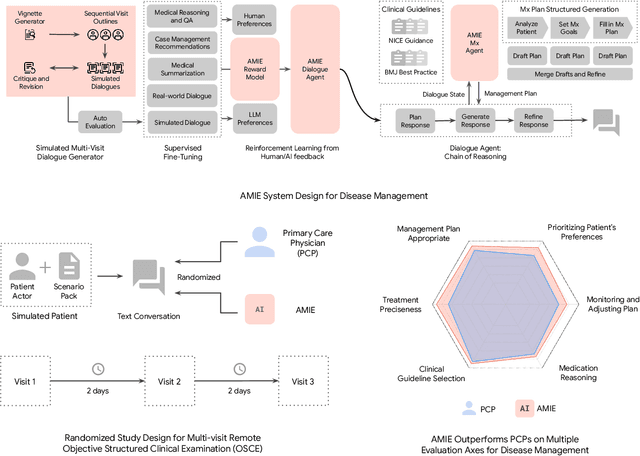

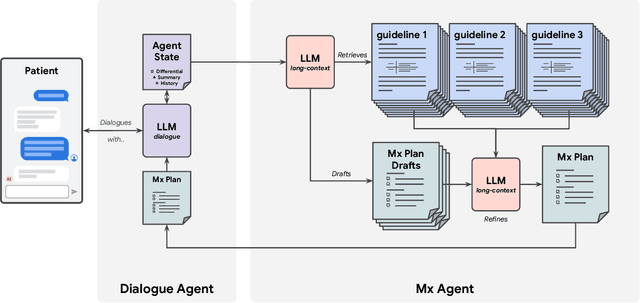
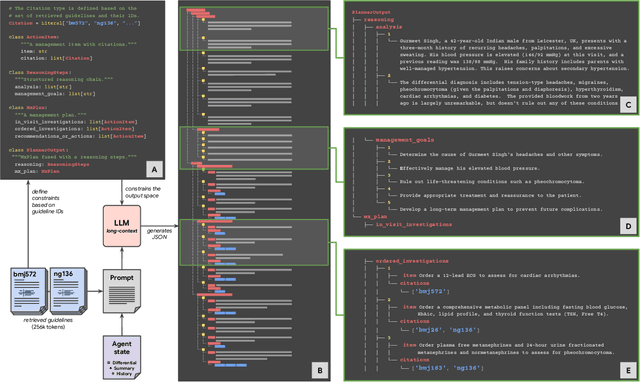
Abstract:While large language models (LLMs) have shown promise in diagnostic dialogue, their capabilities for effective management reasoning - including disease progression, therapeutic response, and safe medication prescription - remain under-explored. We advance the previously demonstrated diagnostic capabilities of the Articulate Medical Intelligence Explorer (AMIE) through a new LLM-based agentic system optimised for clinical management and dialogue, incorporating reasoning over the evolution of disease and multiple patient visit encounters, response to therapy, and professional competence in medication prescription. To ground its reasoning in authoritative clinical knowledge, AMIE leverages Gemini's long-context capabilities, combining in-context retrieval with structured reasoning to align its output with relevant and up-to-date clinical practice guidelines and drug formularies. In a randomized, blinded virtual Objective Structured Clinical Examination (OSCE) study, AMIE was compared to 21 primary care physicians (PCPs) across 100 multi-visit case scenarios designed to reflect UK NICE Guidance and BMJ Best Practice guidelines. AMIE was non-inferior to PCPs in management reasoning as assessed by specialist physicians and scored better in both preciseness of treatments and investigations, and in its alignment with and grounding of management plans in clinical guidelines. To benchmark medication reasoning, we developed RxQA, a multiple-choice question benchmark derived from two national drug formularies (US, UK) and validated by board-certified pharmacists. While AMIE and PCPs both benefited from the ability to access external drug information, AMIE outperformed PCPs on higher difficulty questions. While further research would be needed before real-world translation, AMIE's strong performance across evaluations marks a significant step towards conversational AI as a tool in disease management.
ThoughtSource: A central hub for large language model reasoning data
Jan 27, 2023Abstract:Large language models (LLMs) such as GPT-3 and ChatGPT have recently demonstrated impressive results across a wide range of tasks. LLMs are still limited, however, in that they frequently fail at complex reasoning, their reasoning processes are opaque, they are prone to 'hallucinate' facts, and there are concerns about their underlying biases. Letting models verbalize reasoning steps as natural language, a technique known as chain-of-thought prompting, has recently been proposed as a way to address some of these issues. Here we present the first release of ThoughtSource, a meta-dataset and software library for chain-of-thought (CoT) reasoning. The goal of ThoughtSource is to improve future artificial intelligence systems by facilitating qualitative understanding of CoTs, enabling empirical evaluations, and providing training data. This first release of ThoughtSource integrates six scientific/medical, three general-domain and five math word question answering datasets.
Variational Open-Domain Question Answering
Sep 23, 2022
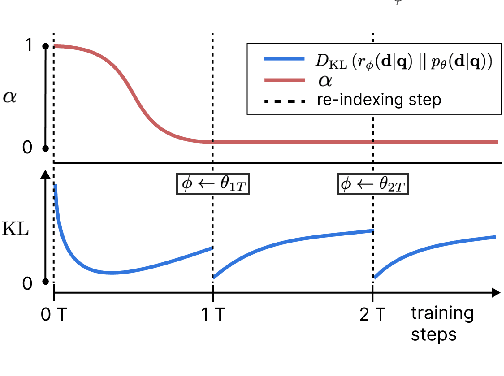


Abstract:We introduce the Variational Open-Domain (VOD) framework for end-to-end training and evaluation of retrieval-augmented models (open-domain question answering and language modelling). We show that the R\'enyi variational bound, a lower bound to the task marginal likelihood, can be exploited to aid optimization and use importance sampling to estimate the task log-likelihood lower bound and its gradients using samples drawn from an auxiliary retriever (approximate posterior). The framework can be used to train modern retrieval-augmented systems end-to-end using tractable and consistent estimates of the R\'enyi variational bound and its gradients. We demonstrate the framework's versatility by training reader-retriever BERT-based models on multiple-choice medical exam questions (MedMCQA and USMLE). We registered a new state-of-the-art for both datasets (MedMCQA: $62.9$\%, USMLE: $55.0$\%). Last, we show that the retriever part of the learned reader-retriever model trained on the medical board exam questions can be used in search engines for a medical knowledge base.
Can large language models reason about medical questions?
Jul 17, 2022
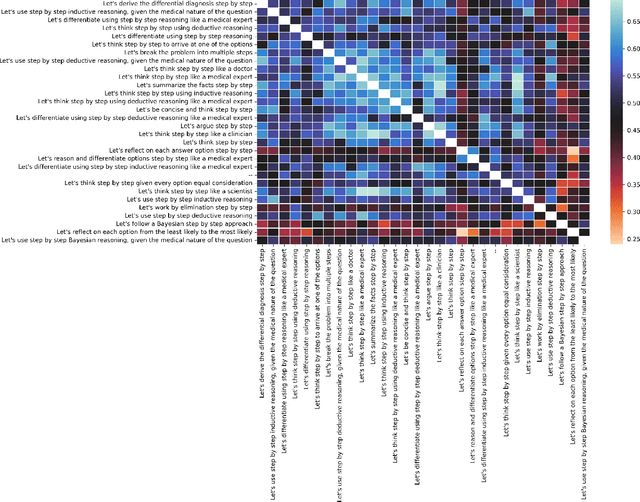


Abstract:Although large language models (LLMs) often produce impressive outputs, they also fail to reason and be factual. We set out to investigate how these limitations affect the LLM's ability to answer and reason about difficult real-world based questions. We applied the human-aligned GPT-3 (InstructGPT) to answer multiple-choice medical exam questions (USMLE and MedMCQA) and medical research questions (PubMedQA). We investigated Chain-of-thought (think step by step) prompts, grounding (augmenting the prompt with search results) and few-shot (prepending the question with question-answer exemplars). For a subset of the USMLE questions, a medical domain expert reviewed and annotated the model's reasoning. Overall, GPT-3 achieved a substantial improvement in state-of-the-art machine learning performance. We observed that GPT-3 is often knowledgeable and can reason about medical questions. GPT-3, when confronted with a question it cannot answer, will still attempt to answer, often resulting in a biased predictive distribution. LLMs are not on par with human performance but our results suggest the emergence of reasoning patterns that are compatible with medical problem-solving. We speculate that scaling model and data, enhancing prompt alignment and allowing for better contextualization of the completions will be sufficient for LLMs to reach human-level performance on this type of task.
Image Super-Resolution With Deep Variational Autoencoders
Mar 17, 2022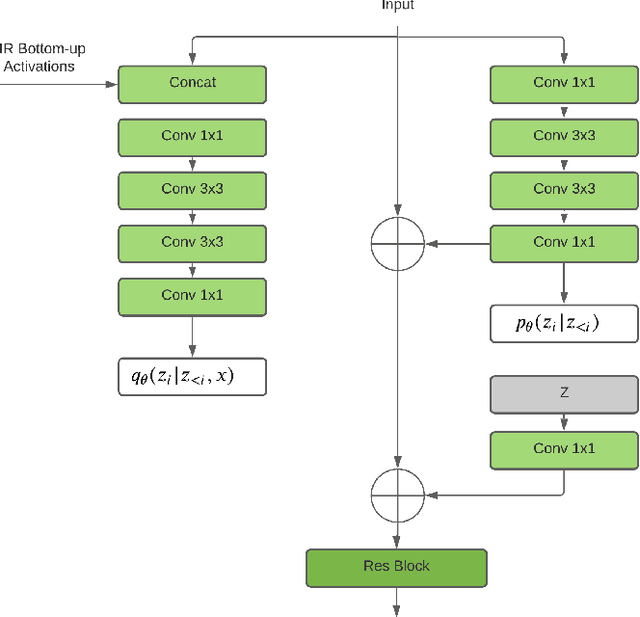

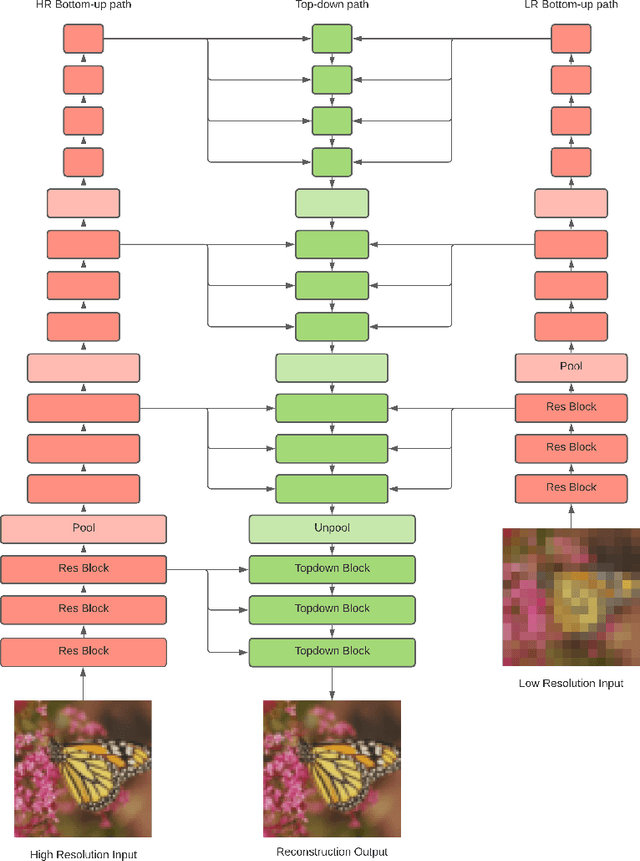
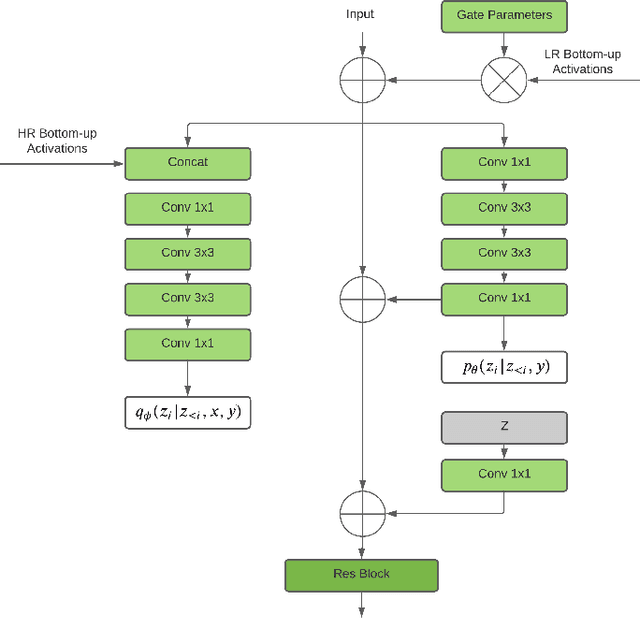
Abstract:Image super-resolution (SR) techniques are used to generate a high-resolution image from a low-resolution image. Until now, deep generative models such as autoregressive models and Generative Adversarial Networks (GANs) have proven to be effective at modelling high-resolution images. Models based on Variational Autoencoders (VAEs) have often been criticized for their feeble generative performance, but with new advancements such as VDVAE (very deep VAE), there is now strong evidence that deep VAEs have the potential to outperform current state-of-the-art models for high-resolution image generation. In this paper, we introduce VDVAE-SR, a new model that aims to exploit the most recent deep VAE methodologies to improve upon image super-resolution using transfer learning on pretrained VDVAEs. Through qualitative and quantitative evaluations, we show that the proposed model is competitive with other state-of-the-art methods.
Optimal Variance Control of the Score Function Gradient Estimator for Importance Weighted Bounds
Aug 05, 2020



Abstract:This paper introduces novel results for the score function gradient estimator of the importance weighted variational bound (IWAE). We prove that in the limit of large $K$ (number of importance samples) one can choose the control variate such that the Signal-to-Noise ratio (SNR) of the estimator grows as $\sqrt{K}$. This is in contrast to the standard pathwise gradient estimator where the SNR decreases as $1/\sqrt{K}$. Based on our theoretical findings we develop a novel control variate that extends on VIMCO. Empirically, for the training of both continuous and discrete generative models, the proposed method yields superior variance reduction, resulting in an SNR for IWAE that increases with $K$ without relying on the reparameterization trick. The novel estimator is competitive with state-of-the-art reparameterization-free gradient estimators such as Reweighted Wake-Sleep (RWS) and the thermodynamic variational objective (TVO) when training generative models.
BIVA: A Very Deep Hierarchy of Latent Variables for Generative Modeling
Feb 06, 2019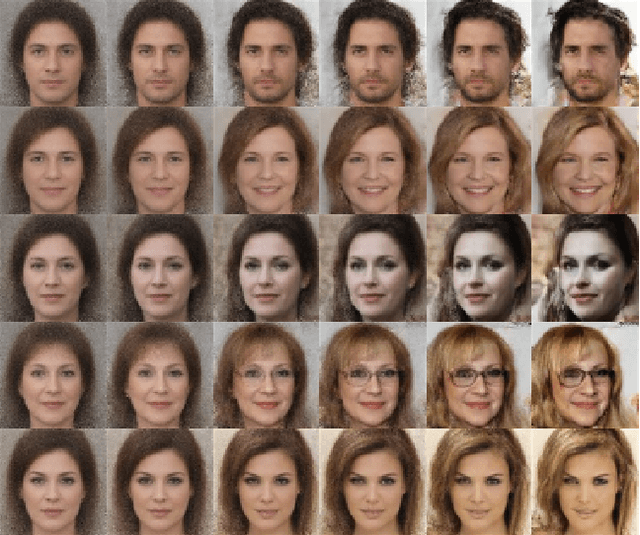

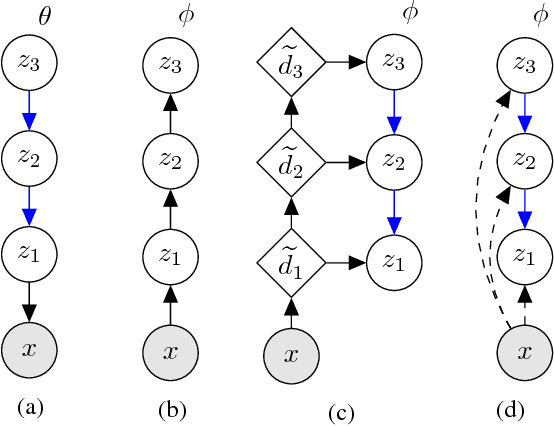
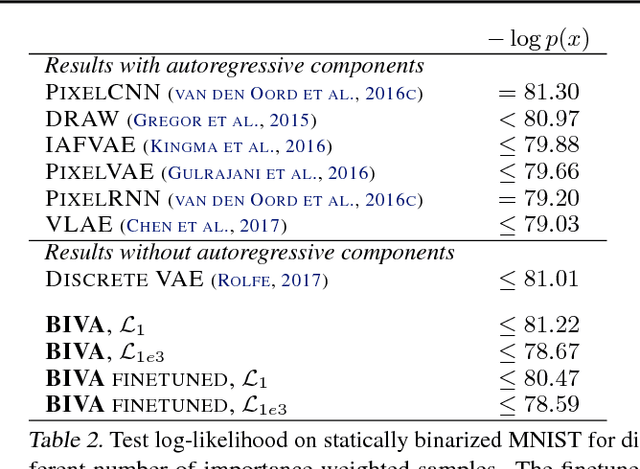
Abstract:With the introduction of the variational autoencoder (VAE), probabilistic latent variable models have received renewed attention as powerful generative models. However, their performance in terms of test likelihood and quality of generated samples has been surpassed by autoregressive models without stochastic units. Furthermore, flow-based models have recently been shown to be an attractive alternative that scales well to high-dimensional data. In this paper we close the performance gap by constructing VAE models that can effectively utilize a deep hierarchy of stochastic variables and model complex covariance structures. We introduce the Bidirectional-Inference Variational Autoencoder (BIVA), characterized by a skip-connected generative model and an inference network formed by a bidirectional stochastic inference path. We show that BIVA reaches state-of-the-art test likelihoods, generates sharp and coherent natural images, and uses the hierarchy of latent variables to capture different aspects of the data distribution. We observe that BIVA, in contrast to recent results, can be used for anomaly detection. We attribute this to the hierarchy of latent variables which is able to extract high-level semantic features. Finally, we extend BIVA to semi-supervised classification tasks and show that it performs comparably to state-of-the-art results by generative adversarial networks.
 Add to Chrome
Add to Chrome Add to Firefox
Add to Firefox Add to Edge
Add to Edge